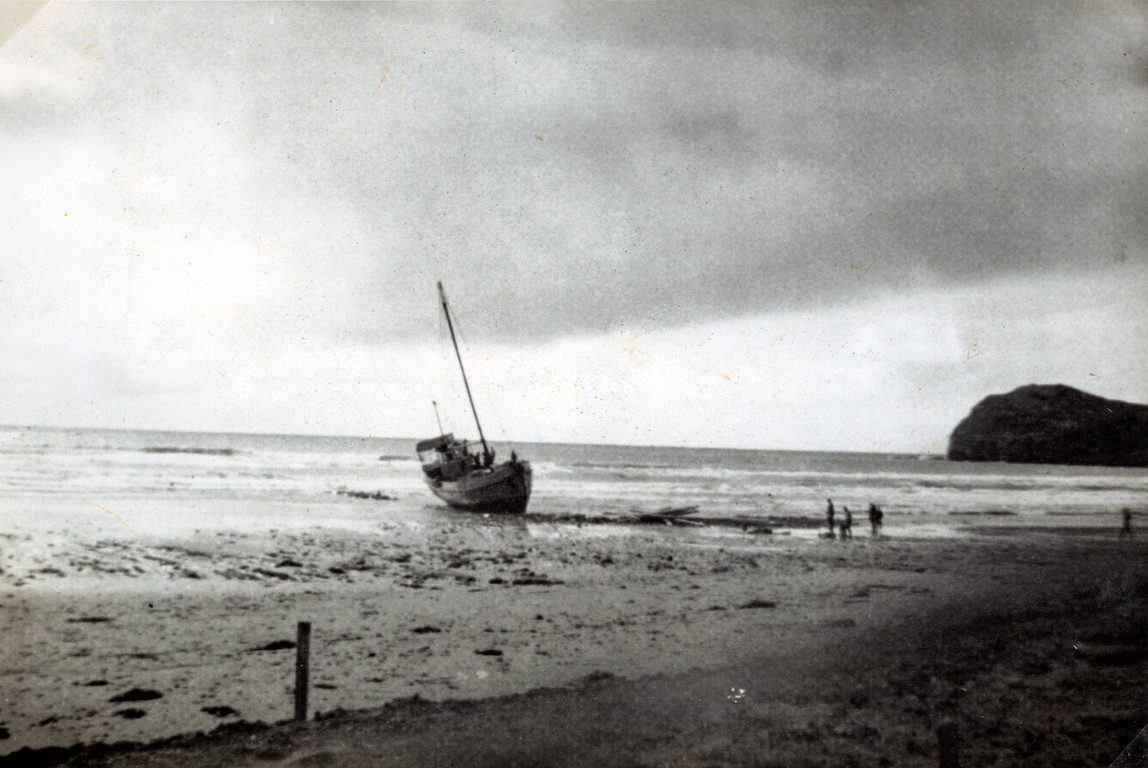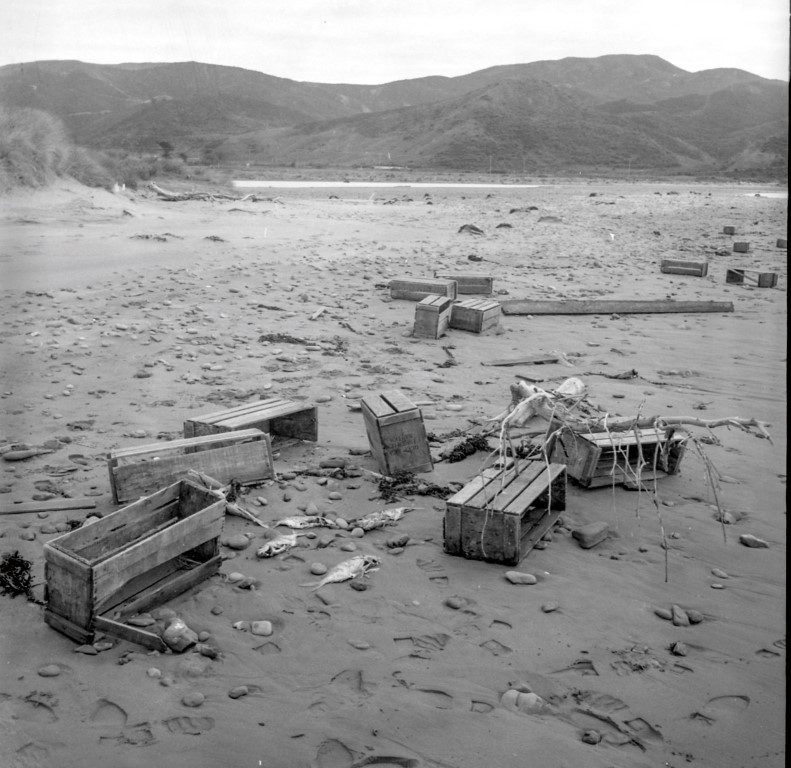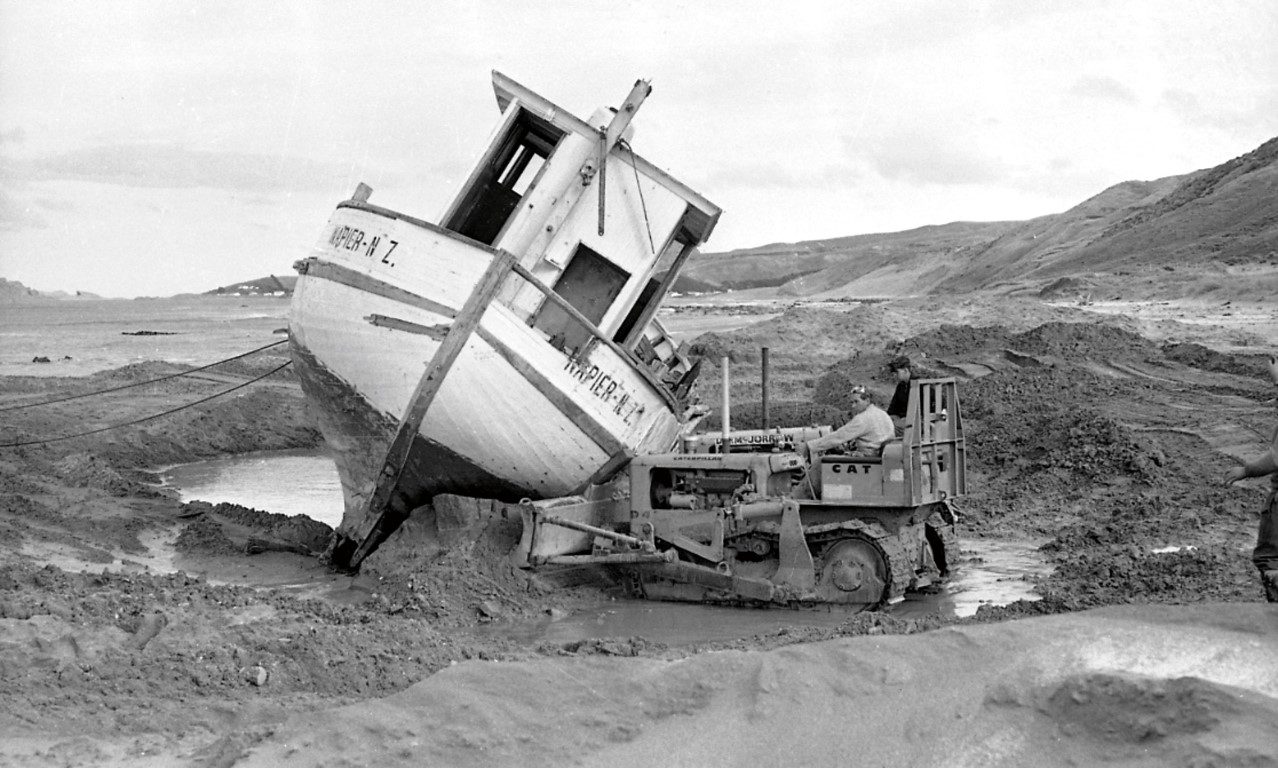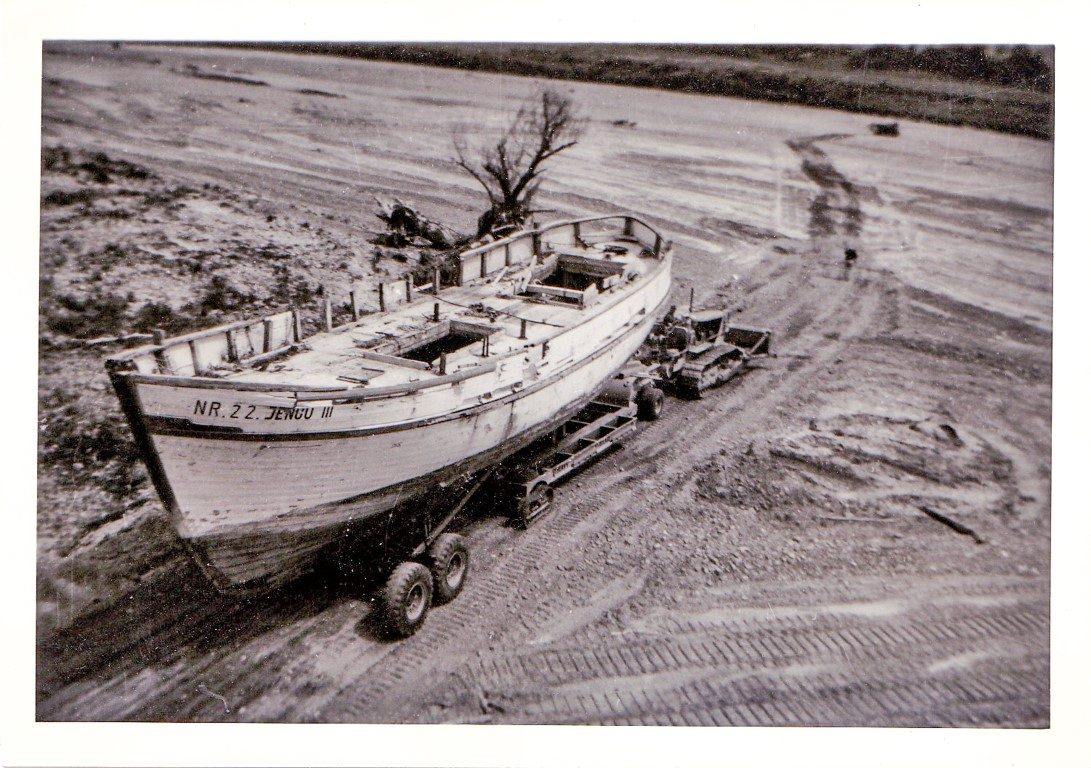

The Wairarapa coastline’s legacy includes a long litany of shipwrecks. One of the most colourful was the fishing trawler Jenco III. She spent two years stranded on a Castlepoint beach in the early 60s but was salvaged and lived to fish another day. Story by Mark Pacey.
Jenco III was one of three Napier-based fishing vessels built in Norway – her sisters were Jenco I and Jenco II. Built from Norwegian pine in 1958 she was 65’ LOA and powered by a 150hp diesel. The vessels’ voyage to New Zealand (via Panama) took two months.

All three had double-skinned hulls and were considered to be among the most seaworthy small craft in service at the time. For the next four years the trio operated a successful fishing business out of Hawke’s Bay. There were plans for a fourth sister, but this never eventuated.
On 31 August 1962 Jenco III departed Napier. Two days later her hold held over two tonnes of fish. Captain Ole Vevand and crewman Garth Nevard decided to spend the night anchored off Castlepoint.
As darkness fell the weather changed – the swells grew bigger and the wind stronger. Vevand had to make a decision. He later recalled “I thought it would only be a quick blow, but by 11pm the wind had swung more to the south. At 4am there was another wind change, this time to the south-east and a big swell started. I decided to haul in our anchor and head for home.”
The boat began to drift as they retrieved the anchor. They felt a shudder as the keel hit the rocky bottom. Believing the damage to be limited, Vevand headed for open sea. But a check below showed things were much worse. The hull had been ruptured and she was taking on water. Knowing that they couldn’t possibly make port, beaching her was the only option.
It was pitch black and the two men had no idea where they were. They could hear the surf breaking on the shore – and then Jenco struck. They cut the engine and let the swell drive them ashore. She came to rest at 4:30am, just 30 minutes after weighing anchor. Unsure of where they were the men decided to stay on the stricken vessel until daybreak.

With sunrise they took in their surroundings. They’d come ashore at Whakataki, north of Castlepoint. The tide was falling and they were able to make it ashore without any difficulty. At the Whakataki Hotel they had a much-deserved breakfast and contacted the Castlepoint lighthouse keeper.
Jenco’s owner, Jens Jenssen, needed to be informed of the stranding – the lighthouse keeper was able to do this. After a meal and a rest the crew returned to the vessel to assess the damage and waited for Jenssen to arrive. Jenco was pulled further up the beach until it could be worked out what was to be done with her.
The inquiry
An inquiry was held a week later to determine the cause of the stranding. Vevand and Nevard were questioned and asked to make statements. The official file on the inquiry (in Wellington’s Archives New Zealand) runs to 19 pages of typed text. Superintendent Howell of the Mercantile Marine issued his statement as to the cause and how it could have been prevented.
“Possibly the casualty could have been avoided if the vessel had steamed seawards during the raising of the anchor, and the wreck would not have occurred if the Southerly had been ridden out at sea.”
Despite this statement he believed the stranding was an accident and saw no reason to take the inquiry any further.

Meanwhile, Jenco sat on the sandy beach north of Castlepoint. The crew had stripped her of all the valuable fittings. The insurance company said there was no hope of re-floating her. She was not a navigational hazard and, according to the Receiver of Wrecks, there was no obligation to remove her. So Jenco stayed put.
Word about the stranded boat soon got around and Jenco became a tourist attraction. The Davies family, who owned a bach at Castlepoint, visited her at the end of 1962. Ten-year-old Jennifer remembers going to see the beach’s new feature.
“I got a camera for Christmas that year and some film and took this with me to the beach. I had heard about the wreck. My parents must have read it in the papers. I remember walking out along the beach, being careful to keep the sand out of my camera. I didn’t think it looked that big when you looked at the sea. The wreck by that time was filling with sand and looking a bit battered. It also smelled a bit fishy so we didn’t try going into it. I took a few photos of it and when they were developed, I put them in an album which I still have.”
Salvage
1962 rolled into 1963 and still Jenco stayed put. But a serious salvage attempt began over a year later – in May 1964. Hastings contractor Vic Watkins, with the aid of two bulldozers and a Scammel recovery vehicle, succeeded in hauling Jenco up the beach.

Seven more months passed before she was winched safely aboard a trailer. Led by a Scammell, the total length of the rig was 86 feet. But the trip from Castlepoint area ran into trouble a minute into the journey when the Scammell lost traction. A front-end loader from the Masterton County Council had to assist to get the rig over the gravel road leading up to the hill. Once clear, the Scammell was free to continue its journey.
Watkins drove the Jenco home and was joined by his son Kevin, who recalls the adventure. “It was the first week in January, stinking hot sitting in the crew seat of the Scammell, engine’s 102bhp roaring as we headed north from Masterton. The Jenco was riding smoothly on her transporter and jinker and it wasn’t difficult to hit top gear and 21mph on the flat, straight road.

“An overhead railway bridge forced us to go off-road, through a farm, across the railway line and back onto the highway. Just one hour lost. Then onwards to the Manawatu River at Ngaparuru. The bridge was too narrow, so down to the river and with the aid of a D8 Caterpillar we unhitched and winched the Jenco through the river.
“That was a very big pull and must have been a great sight for those driving across the bridge and looking down at a fishing trawler motoring through the river. Then onto the road again and we made it to Woodville as sun set. A beer, a feed and into the pit.
“Next morning we had a 5am start. We made Dannevirke in good time, over the undulating road to Takapau where the highway bridge was a quarter inch lower than our load. That’s when pneumatic tyres come into their own. No time for any thought of traversing the old steep road, so the Scammell dropped into second gear and charged ahead. The steel brow off the Jenco scraped its way under the bridge, concrete flaking off in clouds leaving two parallel gauges visible still today.

“Heading into Waipukurau at lunchtime, the sweat was pouring off Vic who was driving. It must have been 100 degrees-plus in that cab, and myself, ears deafened by the trusty Gardner motor. We had no time to stop, even for a sandwich.
“Traffic was being stopped to let us pass, we finally reached Te Aute hill, quite a long, steep descent and we flew down there but couldn’t get past the pub at the bottom. A five-minute stop, a cold ale and we were on our way to Hastings, arriving there around 4pm and straight through to Napier an hour later. Job done, two long hard days. Jenco was home”.
Rebirth & Death
After much-needed repairs, Jenco III rejoined her sisters and was back out in the bay fishing again. The two older sisters retired from service in the early 1980s and were scrapped. Jenco III continued for a few more years but began to show her age.
She was plagued by leaks and continually sank while moored at Napier’s West Quay. By the mid-1990s a pump had been installed to keep the water out of the hull but, when the power was disconnected one night, Jenco sank for the last time.
After four decades in which she survived a stranding, being left on a beach for two years and multiple sinkings, Jenco III’s life ended when she was broken up for firewood.




